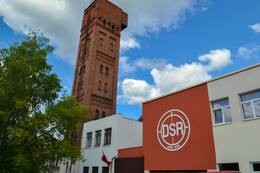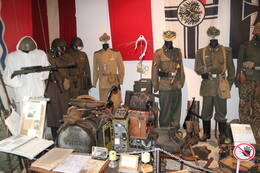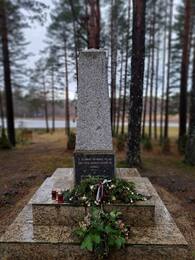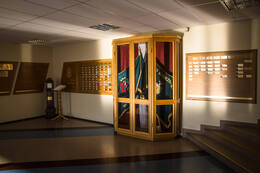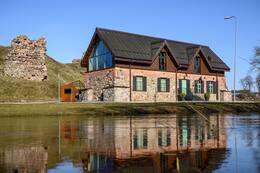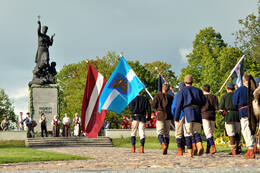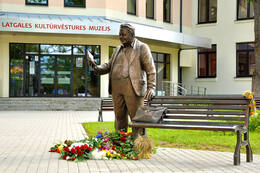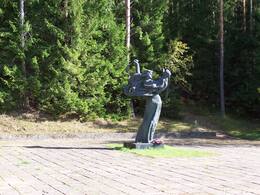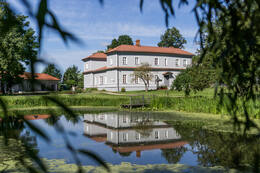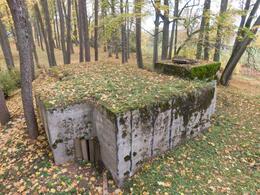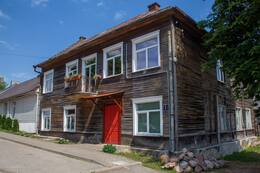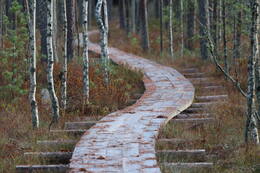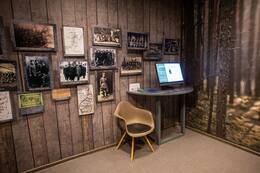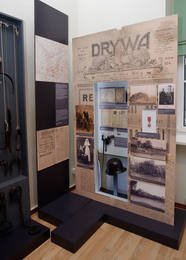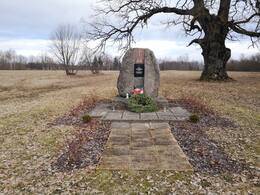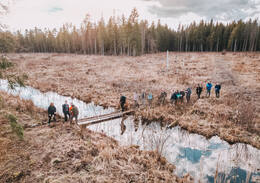Latgala – sritis prie Latvijos rytinės sienos
Daugpilio tvirtovė
Daugpilio tvirtovė – valstybinės reikšmės architektūros ir kultūros istorijos paminklas. Tai paskutinė pasaulyje pastatyta bastioninio tipo tvirtovė ir vienintelis Vidurio Europoje išlikęs XIX a. pirmosios pusės tvirtovės pavyzdys, išlikęs be didesnių pokyčių.
Tvirtovės statyba pradėta 1810 m., carinei Rusijai rengiantis Napoleono kariuomenės įsiveržimui, ir truko iki 1878 m. Dar nebaigus statybos, 1812 m., prie tvirtovės vyko rusų ir prancūzų karių mūšiai. Nors po Napoleono karų statybos buvo tęsiamos, jau tuomet tvirtovė ėmė prarasti savo karinę reikšmę.
Pirmojo pasaulinio karo metais (1915–1918) tvirtovė buvo Rusijos kariuomenės logistikos ir palaikymo bazė. 1918 m. vasarį ją užėmė vokiečių kariuomenė, o gruodį – bolševikai. 1920 m. sausį tvirtovę užėmė lenkų kariai, padėję Latvijos kariuomenei išlaisvinti Latgalą nuo bolševikų. Tarpukariu, 1920–1940 m., tvirtovėje buvo dislokuota Latvijos kariuomenės 4-oji Žiemgalos divizija.
1940 m. okupavus Latviją, tvirtovėje įsikūrė Raudonosios armijos daliniai, o vokiečių okupacijos metais čia buvo karo belaisvių stovykla „Stalag-340“. Po 1944 m. sovietų sugrįžimo tvirtovė vėl atiteko sovietinei armijai. Latvija tvirtovę atgavo tik 1993 m., kai iš jos pasitraukė Rusijos kariuomenė.
Daugpilio šratų gamykla
Daugpilio šratų gamykla, įkurta 1885 m., yra seniausia šaudmenų gamykla Šiaurės Europoje. Tai vienintelė tokio tipo gamykla Baltijos šalyse ir vienas seniausių pramoninio paveldo objektų Latvijoje. Joje veikia vienintelis Europoje švino šratų liejimo bokštas.
Gamykla jau daugiau nei šimtmetį gamina aukštos kokybės medžioklinius šratus ir šią veiklą tęsia iki šiol. Joje išlikę XIX a. įrenginiai ir konstrukcijos, sumontuoti Pirmojo ir Antrojo pasaulinio karų metu. Šiuo metu šratų gamybai naudojama ir moderni įranga.
Lankytojai gali apžiūrėti istorinę ekspoziciją, šratų liejimo cechą ir užlipti į unikalų 31,5 m aukščio bokštą, po kuriuo yra 13,5 m gylio aušinimo šulinys. Gamykla yra populiari turistų lankoma vieta, pritraukianti tiek vietinius, tiek užsienio lankytojus, kurie gali susipažinti su XIX a. pramonės paveldu ir pamatyti, kaip veikia senoji technika. Apžiūrėję gamyklą lankytojai gali išbandyti joje gaminamus šratus gamyklos šaudykloje.
WW2 – Antrojo pasaulinio karo ekspozicija Agluonoje
Antrojo pasaulinio karo ekspozicija Agluonoje – dar vadinama Karo muziejumi – įkurta 2008 m. ir yra viena didžiausių bei įdomiausių tokio pobūdžio ekspozicijų Latvijoje. Kolekcija nuolat papildoma naujai įsigytais eksponatais, karo dalyvių ir karo meto kartos žmonių pasakojimais.
Muziejaus fondo pagrindą sudaro per Antrąjį pasaulinį karą naudoti ginklai, ekipuotė, amunicija ir uniformos. Tai pat galima pamatyti įvairius buities reikmenis, lėktuvų nuolaužas ir kitus eksponatus. Vienas vertingiausių ir išskirtiniausių eksponatų yra karo lauko pašto laiškai tarp oberleitenanto Augusto ir jo mylimosios Martos. Penkerius karo metus trukęs dviejų mylinčių žmonių susirašinėjimas baigėsi laimingai. Ekspozicijos fone rodomos karo meto kronikos. Ekspozicija nėra politizuota – joje vienodai pristatomos abi kariaujančios pusės, todėl lankytojai turi galimybę neskirstydami į gerą ir blogą, lengvai suprasti ekspoziciją.
Latvijos laisvės kovų paminklas 3-iojo Jelgavos pėstininkų pulko mūšių vietoje
Paminklas 3-iojo Jelgavos pėstininkų pulko 1920 m. sausio 16 d. laisvės kovai Latgaloje. Su užrašu: „3-iojo Jelgavos pėstininkų pulko mūšių, pergalingo žygio per Latgalą vieta. 1920.16.I. Mes atnešėme Latvijai saulę, laisvę ir nepriklausomybę“.
Paminklas atidengtas 1936 m. Rugpjūčio 16 d. jį pašventino generolas Žanis Bachas (1885–1941), o jį pašventino pastorius Adamas Vizulis (1891–1970). Paminklo projekto autorius buvo inžinierius Zilēvičs.
Latvijos Nepriklausomybės karo (1918–1920 m.) operacija, skirta Latgalai išlaisvinti, prasidėjo 1920 m. sausio 3 d. Iki sausio vidurio Latvijos ir Lenkijos armijos išlaisvino Daugpilį ir didžiąją dalį pietinės Latgalos iki Dagdos–Indros linijos nuo bolševikų pajėgų, užgrobusių valdžią Rusijoje. Sausio 9 d. Latvijos armija pradėjo puolimą Šiaurės Latgaloje, sparčiai žygiuodama Karsavos ir Pitalovos stočių link.
Tarp dviejų puolimo krypčių liko bolševikų kontroliuojama teritorija aplink Varaklianus, Vilanius ir Rėzeknę. Sausio 20 d. Latvijos armijos daliniai pradėjo Rėzeknės išvadavimo operaciją. Rėzeknė buvo išlaisvinta sausio 21 d. Latvijos armija, per visą Rytų fronto plotą, iki sausio pabaigos pasiekė latvių gyvenamų žemių sieną. Jau vasario 1 d. Sovietų Rusija pasirašė paliaubų sutartį su Latvija.
Pergale Latgalos mūšiuose buvo užtikrinta Latvijos rytinė siena ir atsirado galimybė prijungti Latviją prie Latvijos. Latvijos kariuomenė galutinai suvienijo Latviją ir paskelbė nepriklausomybę 1920 m.
Paminklas, datuotas 1920.16.I., skirtas atminti akimirką, kai 3-iasis Jelgavos pėstininkų pulkas užėmė pradines pozicijas prieš Rėzeknės išvadavimo operaciją.
Valstybės sienos apsaugos muziejus
Muziejus įsikūręs Latvijos valstybės sienos apsaugos kolegijos patalpose Rėzeknėje.
Muziejuje veikia Sienos apsaugos istorijos tyrimų skyriaus ekspozicija, supažindinanti su Latvijos sienos apsaugos istorijos chronologija nuo 1919 m. iki šių laikų. Surinkti daiktai ir nuotraukos pasakoja apie Latvijos pasieniečių tarnybą ir kasdienį gyvenimą nuo 1919 m. iki 1940 m. Taip pat atskleidžiamas tragiškas pasieniečių likimas po 1940 m. šalies okupacijos. Tuo metu pasieniečiai kartu su savo artimaisiais buvo vieni pirmųjų represuotų asmenų.
Muziejuje eksponuojami daiktai, susiję su atkurtos Sienos apsaugos tarnybos veikla po Latvijos nepriklausomybės atkūrimo: uniformos, ekipuotė, apdovanojimai ir skiriamieji ženklai, kurie laikui bėgant buvo nuolat tobulinami ir keitėsi.
Neatsiejama ekskursijos dalis – apsilankymas Kinologijos centre, kur galima stebėti dresuojamų tarnybinių šunų pasirodymus.
Apsilankymui būtina išankstinė registracija.
Laisvosios valstybės brangenybių namai
Nepriklausomos valstybės palikimą saugantys namai yra šalia Rėzeknės pilies griuvėsių.
Išskirtinėje ekspozicijoje pristatoma keli šimtai istorinių eksponatų iš Latvijos ir užsienio privačių kolekcijų, apimančių 1918–1940 m. laikotarpį, bei skirtingus Latgalos ir Rėzeknės istorijos puslapius. Supažindinama su Pirmosios nepriklausomos Latvijos valstybės karinių ir civilinių apdovanojimų istorija, įvairių valstybinių ir visuomeninių organizacijų veikla, vykusia nuo Latvijos nepriklausomybės karo iki Antrojo pasaulinio karo.
Tai didžiausia Latvijoje kolekcija, pristatanti nepriklausomos valstybės karinius ir civilinius apdovanojimus bei skiriamuosius ženklus.
Antrajame aukšte įrengta keičiamų parodų salė, kurioje bent kartą per metus surengiama nauja paroda. Lankytojai jau turėjo galimybę pamatyti išskirtinę porceliano dirbinių kolekciją, prabangius laikrodžius iš Prancūzijos ir įvairius Latgalos peizažus vaizduojančius paveikslus.
Paminklas „Vieningi dėl Latvijos“ (Vienoti Latvijai) arba Latgalos Mara
Rėzeknėje stovi paminklas „Vieningi dėl Latvijos“, žmonių vadinamas „Latgalos Mara“. Pagrindinė figūra – moteris su kryžiumi rankoje – simbolizuoja 1920 m. iš bolševikų valdžios išvaduotą Latgalą ir jos krikščionišką dvasią.
Paminklo idėja gimė XX a. 3 deš. pabaigoje, ją inicijavo Latgalos visuomenės veikėjai. 1930 m. birželio 8 d. buvo pašventintas pirmasis paminklo pamatų akmuo. 1934 m. birželį buvo paskelbtas konkursas, kurį laimėjo Karlio Jansono projektas. 1939 m. rugsėjo 8 d. paminklas iškilmingai atidengtas. Pašventinimo apeigoms vadovavo vyskupas Jazepas Rancanas.
Sovietų okupacijos laikotarpiu, 1940 m. lapkritį paminklas buvo nugriautas. Bronzinės skulptūros sunaikinti nespėjo, todėl vokiečių okupacijos metais, 1943 m. rugpjūčio 22 d. paminklas buvo atstatytas. Grįžus sovietų okupacijai, iš pradžių buvo nupjautas kryžius, o 1950 m. paminklas visiškai sunaikintas.
Jo vietoje buvo pastatytas Lenino paminklas, kuris buvo nugriautas iškart po Latvijos nepriklausomybės atgavimo 1991 m. Atgimimo laikotarpiu, 1989 metais, kilo idėja atkurti istorinį paminklą „Vieningi dėl Latvijos“. Paminklą, remdamasis savo tėvo medžiaga ir nuotraukomis, atkūrė Karlio Jansono sūnus skulptorius Andrejus Jansonas kartu su Inta Folkmane. Atnaujintas paminklas buvo atidengtas 1992 m. rugpjūčio 13 d. per Pirmąjį pasaulinį latgalių susitikimą.
Latgalos kultūros istorijos muziejus
Latgalos kultūros istorijos muziejuje Rėzeknėje veikia trys nuolatinės ekspozicijos. Viena jų – „Rėzeknė laikmečių sandūroje“ – pasakoja apie daugiau kaip septynis šimtmečius besitęsiančią miesto istoriją. Didelė ekspozicijos dalis skirta XX a. įvykiams, karams ir besikeitusiems laikotarpiams: Pirmasis pasaulinis karas, Nepriklausomybės karas, Antrasis pasaulinis karas, 1944 m. sovietų bombonešių antskrydis, taip pat karo belaisvių stovykla „Stalag 347“. Ekspozicijoje yra fotografijų stendas, skirtas Rėzeknės kareivių likimams karo metais.
Latvijos nepriklausomybės laikais Rėzeknėje buvo dislokuotas Latvijos kariuomenės 9-asis Rėzeknės pėstininkų pulkas, kuris tapo neatsiejama miesto visuomeninio gyvenimo ir sporto renginių dalimi – ypač per lapkričio 11 d. (Laisvės gynėjų dienos) ir lapkričio 18 d. (Latvijos nepriklausomybės dienos) minėjimus.
Ančupanų memorialas Antrojo pasaulinio karo aukoms atminti
Memorialas yra Ančupanuose, Rėzeknės apskrityje. Jis buvo sukurtas, siekiant įamžinti Audrinių tragediją – 1942 m. nacistinės Vokietijos okupacijos metu įvykdytą civilių gyventojų naikinimo operaciją Audrinių kaime, Makašanų seniūnijoje, Rėzeknės apskrityje.
Nuo 1941 m. rudens Audriniuose slapstėsi keli pabėgę Raudonosios armijos karo belaisviai. 1941 m. gruodžio 18 d. buvo nustatyta jų buvimo vieta, ir per susišaudymą žuvo 4 pagalbinės saugumo policijos pareigūnai. Gruodžio 24 d. 203 Audrinių gyventojai buvo suimti ir įkalinti Rėzeknės kalėjime. 1942 m. sausio 3 d. dauguma suimtųjų buvo sušaudyti netoli Ančupanų kalvos, maždaug už 5 km nuo Rėzeknės. Sausio 4 d. Rėzeknės turgaus aikštėje viešai buvo sušaudyta 30 Audrinių kaime suimtų vyrų, o pats kaimas sudegintas.
Memorialas atidengtas 1974 m. liepos 27 d. Jo autorius – kraštovaizdžio architektas Alfonsas Kiškis (1910–1994). Dešinėje kelio pusėje augančios nuolat žaliuojančios eglės simbolizuoja žmones, išrikiuotus į eilę sušaudymui, o kitoje kelio pusėje esanti akmeninė siena – šaudytojus. Žemesnėje dalyje – Kančios slėnyje – pro masines sušaudytų žmonių kapavietes veda lauko rieduliais grįstas takas, kuris baigiasi prie betoninės sienos su užrašu: „Jie mirė, kad gyventum tu“. Toliau kyla laiptai į Gyvybės aikštę, kur stovi skulptūra „Motina obelis“, kurią sukūrė skulptorė Rasa Kalninia-Grinberga (1936 m.).
Paroda „Ludzos kraštas 1918–1945. Tegyvena Latvija amžinai!“ Ludzos kraštotyros muziejuje
Ludzos kraštotyros muziejaus paroda „Tegyvena amžinai Latvijoje! 1918–1945“ atspindi svarbų istorinį Rytų Latgalos vystymosi etapą nuo 1918 iki 1945 m. Parodoje eksponuojami įvairūs šio istorinio laikotarpio relikvijos. Tarp jų – daiktai, kurie kadaise priklausė ludziečių gyventojui ir Laisvės kovų dalyviui R. Kalniniui. Erdvės meninis apipavidalinimas leidžia lankytojams pajusti to meto atmosferą, kai Latviją užliejo masinių trėmimų banga. Centrinė relikvija, vaizduojanti šį istorinį etapą, yra medinis kryžius, kurį pagamino represuotas katalikų kunigas Kazimiras Vitanis. Antrojo pasaulinio karo mūšio lauko instaliacija sukuria emociškai ryškią to meto atmosferą. Parodos lankytojai taip pat gali susipažinti su sovietų ir vokiečių armijų karo apdovanojimais. Parodoje eksponuojamos senos Ludzos nuotraukos suteikia lankytojams supratimą apie miesto vaizdą prieš ir po Antrojo pasaulinio karo.
Lydumniekų istorinių liudijimų saugykla
Lydumniekų karo ekspozicija, dar vadinama Lydumniekų istorinių liudijimų saugykla, įsikūrusi Zabalotjės / Aizpūrės kaimo centre, Lydumniekų seniūnijoje, buvusiame kolūkio tarybos pastate, Zabalotjės dvaro parke. Ekspozicija sukurta vietos gyventojų pastangomis – kaime gyvenantys patriotai istoriniame pastate eksponuoja savo asmenines kolekcijas ir vietinių žmonių dovanotas relikvijas.
Ekspoziciją sudaro trys dalys. Pagrindinė ir didžiausia dalis centrinėje patalpoje skirta Antrajam pasauliniam karui. Joje eksponuojamos tankų, patrankų, lėktuvų dalys, įvairių kariuomenių kareiviška ekipuotė ir ginkluotės modeliai. Taip pat rodomi kareivių buities reikmenys ir tai, ko reikia kariaujant: gertuvės, katiliukai, šalmai, uniformos, karinės aprangos antsiuvai, amunicijos dėžės ir minų modeliai. Antrojo ekspozicijos dalis supažindina su iki 1941 metais datuotais eksponatais. Čia galima pamatyti Ludzos apskrities gyventojų buities reikmenis, įvairius originalius dokumentus, vadovėlius, sąsiuvinius, laiškus, laikraščius, žurnalus ir kitą to laikmečio medžiagą.
Trečioji ekspozicijos dalis padeda suprasti, koks buvo kolūkio „Līdumnieki“ gyvenimas, tikslai ir veikla.
Antrojo pasaulinio karo bunkeriai Malnavoje ir Hitlerio apsilankymas vo kiečių armijos grupės „Šiaurė“ štabe
Hitlerio apsilankymas vokiečių armijos grupės „Šiaurė“ štabe Malnavoje ir netoliese esantis priešlėktuvinės gynybos bunkeris dažnai minimi kaip susiję objektai. Tačiau juos sieja tik bendra vieta – Malnavos dvaras; jokio tiesioginio ryšio tarp šių įvykių nėra.
1941 m. liepos 12–28 d. Malnavos dvare buvo įsikūręs vokiečių armijos grupės „Šiaurė“ štabas vadovavęs puolimui Leningrado kryptimi. Vieta buvo pasirinkta dėl praktinių priežasčių – buvusiame dvare veikusi Malnavos žemės ūkio mokykla turėjo modernią infrastruktūrą: elektros apšvietimą, centralizuotą vandentiekį, dušus ir kanalizaciją. Štabas buvo įrengtas viename iš dvaro šoninių korpusų, o likusioje pastato dalyje mokykla veikė toliau.
Hitleris štabą aplankė 1941 m. liepos 21 d. Jis kartu su lydinčiais asmenimis atskrido dviem „Junkers“ lėktuvais, lydimais devynių „Messerschmitt“ naikintuvų. Apsilankymas truko vos kelias valandas, bet buvo įamžintas vokiečių fronto kino kronikose ir išliko Malnavos mokinių prisiminimuose.
Maždaug už 70 metrų nuo dvaro stovi priešlėktuvinės gynybos bunkeris, įrengtas 1944 m. pradžioje, kai karo eigoje sovietų aviacija ėmė dominuoti oro erdvėje, o vokiečių karinės pajėgos pradėjo trauktis. Grupės „Šiaurė“ štabas Malnavoje buvo nuo vasario iki liepos vidurio.
Privati ekspozicija „Abrenės kambariai“ (Abrenes istabas)
Privati ekspozicija „Abrenės kambariai“ įsikūrusi Viliakos mieste, istoriniame pastate. Iš pradžių šis pastatas stovėjo senosios Marienhauzeno turgaus aikštėje. Vėliau čia veikė butai, biurai, įvairios parduotuvės, o Antrojo pasaulinio karo metais – latvių savigynos štabas, gestapas ir čekistų būstinė. Ekspozicijose pristatomi įvairūs Viliakos ir jos apylinkių istorijos laikotarpiai bei įvykiai nuo 1920 iki 1960 metų – kai miestelis priklausė Jaunlatgalės, vėliau Abrenės apskričiai. Tarp eksponatų – Stompakų pelkės partizanų štabo daiktai, pasakojantys apie nacionalinį pasipriešinimą Latgaloje, taip pat dokumentai ir fotografijos iš Nepriklausomybės kovų laikotarpio. Naujausioje ekspozicijoje lankytojai gali susipažinti su kadaise garsia motokroso trasa „Baltasis briedis“
Viliakos muziejus
Viliakos muziejus įsikūręs dviejuose pastatuose – 1913 m. statytuose miestelio kultūros istorijai svarbiuose katalikų parapijos namuose ir buvusiame kapucinų vienuolyne, kurio rūsiai glaudžiai susiję su nacionalinių partizanų judėjimu Stompakuose ir sovietų čekistų veikla. Žmonės prisimena, kad šiuose rūsiuose buvo laikomi ir kankinami žmonės. Senajame muziejaus pastate įrengtos kelios ekspozicijos. Viena jų pristato 1920 m. laisvės kovas Šiaurės Latgaloje, Antrojo pasaulinio karo įvykius – žydų holokaustą Viliakoje ir informaciją apie sušaudytas šeimas. Daugiau apie kiekvieną šeimą galima sužinoti pagal gyvenamosios vietos adresą.
Ekspoziciją papildo informacija apie nacionalinių partizanų judėjimą Stompakuose – įvairūs eksponatai: nuotraukos, daiktai. Muziejaus lankytojai gali susipažinti su karinio paveldo vietomis Viliakoje ir jos aplinkinėse vietovėse, pavyzdžiui, kovotojų už Laisvę paminklu Jaškove, kuris sovietmečiu buvo nugriautas ir atstatytas 1990 m., stela, skirta Lačplėsio karo ordinu apdovanotiesiems. Muziejaus ekspozicijoje girdisi Antrojo pasaulinio karo lėktuvo garsas, kaip priminimas apie netoli Viliakos buvo vokiečių aerodromas „Luftwaffe“. Muziejuje galima susipažinti su prisiminimais apie Antrojo pasaulinio karo įvykius Viliakoje ir gauti informacijos apie vokiečių karo belaisvių stovyklą Račuose.
Nacionalinių partizanų būstinė gamtos draustinyje „Stompakų pelkės“ (Stompaku purvi)
Antrojo pasaulinio karo metais Stompakų pelkėje buvo viena didžiausių nacionalinių partizanų būstinių Baltijos šalyse. Šiandien ši teritorija priklauso Stompakų gamtos draustiniui. Pelkių salose esančią gyvenvietę galima pasiekti pažymėtu pėsčiųjų taku.
1945 m. pradžioje Stompakų pelkėje buvusioje nacionalinių partizanų būstinėje gyveno 350–360 žmonių, iš jų – 40 50 moterų. Joje buvo 24 gyvenamieji bunkeriai – pusiau į žemę įkasti statiniai, kuriuose galėjo gyventi 3–8 žmonės. Būstinėje taip pat veikė kepykla, požeminė bažnyčia ir trys antžeminės pašiūrės arkliams. Partizanai rengė išpuolius prieš okupacinio režimo pareigūnus.
1945 m. kovo 2–3 d. čia vyko Stompakų mūšis – didžiausias nacionalinių partizanų susirėmimas Latvijoje. Būstinėje buvusius 350–360 partizanų puolė NKVD 143-asis šaulių pulkas ir vietinio stribų (rus. „isterbiteli“) bataliono kovotojai – iš viso 483 vyrai. Mūšis truko visą kovo 2 dieną. Kovo 3-iosios naktį partizanams pavyko ištrūkti iš būstinės ir pasitraukti į ankstesnės bazės vietą. Mūšyje žuvo 28 partizanai, o NKVD neteko 32 karių.
Šiuo metu Stompakų būstinės vietoje yra atkurti trys bunkeriai – bažnyčia, štabas ir gyvenamasis bunkeris, taip pat 21 bunkerio vieta. Įrengti informaciniai stendai apie būstinę ir mūšį. Galima užsisakyti ekskursijas su gidu.
Ekspozicija „Šiaurės Latgala kovose už laisvę“ (Ziemeļlatgale brīvības cīņās)
Muziejus įsikūręs Balvų dvaro komplekse, buvusiame dvaro klėties pastate.
Ekspozicija supažindina su Latvijos Nepriklausomybės kovų istorija iš Šiaurės Latgalos perspektyvos, pasakoja Latgalos partizanų pulko kūrimosi ir veiklos istoriją. Čia eksponuojamos anksčiau niekur nepublikuotos nuotraukos ir dokumentų kopijos, įskaitant 1919 m. liepos 5 d. įsakymą dėl pulko suformavimo. Ypatingą ekspozicijos dalį sudaro 1919 m. liepos–spalio mėn. rusų kalba rašyti vidiniai pulko įsakymai. Jie atskleidžia šio vietinio karinio dalinio formavimosi ypatumus – jame kartu kovojo latviai, latgaliai, rusai ir žydai. Tik pulkui tapus visaverte Latvijos kariuomenės dalimi ir jį papildžius mobilizuotiems kariams iš kitų Latvijos regionų, vidiniai dokumentai pradėti rengti latvių kalba. Ekspozicijoje pasakojama apie Šiaurės Latgalos išvadavimo operaciją. 1920 m. sausio 9–15 d. Latvijos kariuomenės Latgalos divizijos vykdytų mūšių metu buvo išlaisvintos Viliakos, Jaunlatgalės ir Karsavos apylinkės. Galima apžiūrėti su šia operacija susijusius eksponatus, įskaitant ir Lat galos partizanų pulko veiklą Karsavos išvadavimo metu.
Preilių istorijos ir taikomosios dailės muziejaus paroda „Muziejaus istorijos Latvijai“
Įsikūręs Preilių kultūros centro patalpose.
Preilių istorijos ir taikomosios dailės muziejuje (PVLMM) eksponuojama paroda „Muziejaus istorijos Latvijai“ apie Pirmąjį pasaulinį karą, Nepriklausomybės karą ir Antrąjį pasaulinį karą.
Preilių istorijos ir taikomosios dailės muziejaus ekspozicijos „Muziejaus istorijos Latvijai“ (atidarytos 2018 m.) skyrius „Dryvio istorija“ skirtas Pirmajam pasauliniam karui, Nepriklausomybės karui ir Latgalos išvadavimui, taip pat Lāčplēšanas karo ordino kavalieriams. Ekspozicijos skyrius „Vėliavos istorija“ pasakoja apie sudėtingus Antrojo pasaulinio karo įvykius, kurių metu Preilijos gyventojai nukentėjo nuo trėmimų, Holokausto, dalyvavimo kariaujančių šalių kariniuose daliniuose, o po karo – nacionalinių partizanų gretose. Taip pat eksponuojamas Preilių gyventojui ir žydų gelbėtojui Vladislavui Vuškanui įteiktas medalis „Pasaulio tautų teisuolis“.
Ekskursijos rusų ir anglų kalbomis teikiamos iš anksto susitarus.
Nacionalinių partizanų paminklas Jersikoje
Paminklinis akmuo randasi netoli Jersikos geležinkelio stoties. Ant jo iškaltas užrašas: „LTS(p)A – Latvijos Tėvynės sargybinių (partizanų) junginio kovotojams“. Šis partizanų junginys, kovojęs su komunistiniu okupaciniu režimu, 1945 - 1955 m. vienijo partizanus iš šešių Latvijos apygardų. Paminklinis akmuo yra pirmoji stotelė žygyje „Jersika–Vanagai. Nacionalinių partizanų legendų pėdsakais.“ Maršrutas prasideda prie Jersikos stoties. Keliaujant galima susipažinti su nacionalinių partizanų judėjimo istorija, žymiausiais partizanais ir jų veikla. Toliau kelias veda į miškų glūdumoje paslėpto nacionalinių partizanų bunkerio vietą; liudininkų pasakojimuose nurodytą Tėvynės sargybinių (partizanų) junginio įkūrimo vietą; miške esančią atminimo vietą Avuotnica (latgališkai – Olūtneica), kur įrengta laužavietė. Žygio tikslas – Vanagų bažnyčia, kurioje pamaldas laikė kunigas Antonas Juchnevičius. Apie jį sukurtas filmas „Slapyvardis Vienišius“ (rež. Normundas Pucis). Filme pasakojama apie kunigą, kuris pokariu aktyviai dalyvavo nacionalinių partizanų pasipriešinime Latgaloje. Maršrutas driekiasi buvusių sodybų vietomis, kur dar galima aptikti jų pėdsakų – didingų ąžuolų, pastatų griuvėsių.
Žygiuojama miškais, pelkėmis, raistais, pievomis ir kaimo keliukais. Bendras trasos ilgis – apie 22 km, o ją įveikti galima per maždaug 6 valandas.
Jersikos nacionalinis partizanų žygių maršrutas
Gamtoje sunkiai randamas objektas.
Žygio ilgis: apie 22 km, įveikiamas maždaug per 6 valandas.
Sudėtingumo lygis: vidutinio sunkumo žygis.
Pradinis taškas: Jersiko pradinė mokykla Lyvani savivaldybėje (galima pasiekti traukiniu, autobusu).
Pabaigos taškas: Vanagų bažnyčia Preilių savivaldybėje (viešasis transportas savaitgaliais nekursuoja).
Pastaba: Maršrute yra maudymosi pertraukėlė (vasaros sezono metu), žvejybos galimybės, iškylų vieta ir vienas viešasis tualetas. Maršrutas taip pat tinka mokyklinio amžiaus vaikams, kurie jau turi tokio ilgio žygių patirties.
Leiskitės į žygį iš Jersikos į Vanagus, leisdami sau išbandyti ištvermę, nes žygis veda per miškus, pelkes, viržynus, pievas ir kaimo takus, pažinti žymiausių nacionalinio partizaninio judėjimo veikėjų istoriją, jų veiklą, pamatyti reikšmingiausias vietas, apie kurias pasakojamos vietos legendos ir rašytiniai bendrapiliečių prisiminimai. Takas prasideda prie Jersikos pradinės mokyklos ir veda prie atminimo akmens po senu ąžuolu, toliau pakeliui – iki Jersikos geležinkelio stoties. Ant akmens iškaltas užrašas „LTS(p)A – Latvijos Tėvynės partizanų asociacijos kovotojams. LTS(p)A 1945–1955 m. vienijo šešių Latvijos rajonų nacionalinius partizanus kovoje su komunistiniu okupaciniu režimu“.
Pasivaikščiojimas tęsiasi geležinkelio bėgiais ir vingiuoja palei Jersikos ežerą, kur miškas siūlo gamtos lobius: pavasarį žydinčias raktažolės ir paprastąją viksvą. Artėjimą prie pelkės rodo raktažolės kvapas, tačiau pavasarį ypač stebina jų žydėjimas. Tingai pasivaikščioti neįmanoma, reikia įveikti kelis griovius, perėjus pelkę atsigaivinti – kiekviename žingsnyje samanose lieka vandens, krūmuose žiba spanguolių uogos. Pelkę pakeičia miškas ir šių vietų buvusios sodybos įrodymai – didingi ąžuolai, pastatų griuvėsiai, jaunuolynų apsupta nacionalinio partizanų bunkerio vieta. Takas tęsiasi iki vietos, liudijimuose minimos kaip Tėvynės sargybos (partizanų) draugijos įkūrimo vieta. Miško masyve taip pat slepiasi memorialinė vieta „Avotnīca“ („Olūtneica“), kur įrengtas laužavietė. Stebina miško įvairovė, kaip ir griovių plotis. Žygio tikslas – Vanagų bažnyčia, kurioje tarnavo kunigas A. Juhņevičs, o istoriją pasakoja filmas „Segvārds Vientulis“ (rež. N. Pucis).
Maršruto pradžioje, netoli Jersiko pradinės mokyklos, yra informacinis stendas, kuriame, nuskenavus QR kodą, galima pasiklausyti garso įrašo apie istorinius įvykius ir partizanų kovas. Garso įrašą taip pat galima rasti „IziTravel“ platformoje ČIA . Garso įrašą galima rasti latvių ir anglų kalbomis.
Arenduolės dvaras
Istoriniuose šaltiniuose Arenduolės dvaras pirmą kartą paminėtas XVI a. Laikui bėgant dvaro savininkai ne kartą keitėsi – jis priklausė Grappenbruckų, Lüdinghausenų-Wulffų ir Pliaterių-Zybergų giminėms. Dabartinę išvaizdą dvaras įgavo 1895–1901 m., kai buvo atlikta jo rekonstrukcija. 1921 m. sausio 14 d., remiantis agrarinės reformos įstatymu, dvaras buvo nusavintas ir perduotas Kalupės valsčiaus valdybai. Dvaro rūmai buvo restauruoti, o nuo 1925 m. juose veikė pradinė mokykla ir našlaičių prieglauda. Tarnų name įsikūrė karo invalidų pensionatas. Mokykla ir neįgaliųjų namai veikė iki 1975 m.
1995 m. Arenduolės dvaro rūmus įsigijo privatūs savininkai, kurie ėmėsi jų atnaujinimo. Nuo 2002 m. dvare veikia draugija „Aš Latgalai“, kuri rūpinasi jo išsaugojimu ir vystymu. Lankytojai turi galimybę apžiūrėti atnaujintas patalpas ir susipažinti su didžiausia Latgaloje senovinių daiktų kolek cija. Čia taip pat galima sužinoti apie XX a. istorinius įvykius Latgaloje. Atskira ekspozicija skirta buvusiam Kalupės valsčiaus policininkui Jonui Babriui (1904–1982), kuris 1941 m. birželio 14 d. pasipriešino trėmimų operatyvinei grupei, nušovė milicininką Slicą ir sužeidė komunistų partijos įgaliotinį Juozaną.
Arenduolės dvare galima apsistoti nakvynei ir išsinuomoti patalpas įvairiems renginiams.





